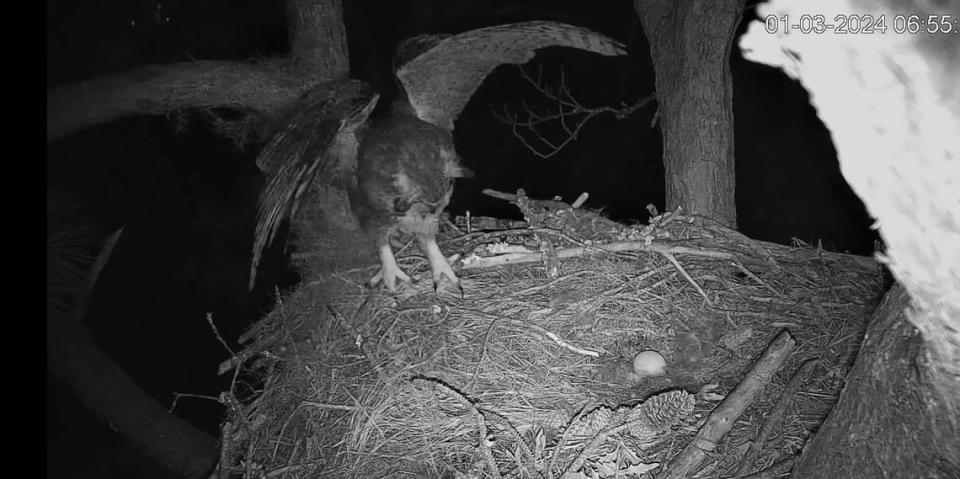Great horned owls stake claim over a well-known Hilton Head nest. Here’s what they left
From the lofty branches of a special pine tree on Hilton Head Island, a nest thick with grasses and sticks holds a mother’s greatest treasure.
A great horned owl mamma laid a single egg during Tuesday evening’s wintry chill, which she, mostly, and her mate will incubate for the next month. And the whole process will be for the world to see. Incubate. Hatch. And flourish.
Fastened near the nest is a Raptor CAM that is monitored by Hilton Head Island Land Trust. Back when a popular bald eagle duo, Harriet and Mitch, staked claim, viewers knew it as Eagle CAM. But this particular nest isn’t choosy about its visitors.
It’s served as a breeding ground for Harriet and Mitch in December 2021, when they welcomed two eaglets. Millions of viewers, national and international, tuned in online. After the two babies fell from the nest due to avian flu, the parents haven’t been spotted back at the nest since their September 2022 visit, according to the land trust.
From late November to early December of 2022, George Banino, president of Hilton Head Island Land Trust, spotted a pair of great horned owls descending into the nest. The duo had quite a stint there, visiting often and dropping off food in the lair. By January 2023, the land trust said the amount of work the owls did to the nest raised hope that the pair were staking claim as a location to lay eggs.
In mid-March, unexpected visitors came to check out the well-known digs. Throughout spring, two ospreys, Charles and Charlotte, flitted in and out of the nest for all to see.
Now, the newest settlers, that have been flying by since September, are looking to stay. At least for several months, if all goes according to plan. While it’s not entirely certain, Robin Storey, Hilton Head Land Island Trust board member, said these could be the same owls Banino first spotted in late-2022.
Great horned owls that call the Lowcountry home, typically lay eggs from December to January and usually lay one egg every two days, but sometimes the wait in between births is closer to five days. A mother can lay between one and four eggs.

Storey said members of the land trust expect (and are hopeful) that the mamma will lay another egg. But for now, it’s a waiting game.
After the dull-white egg hatches, which happens between 28 and 35 days of incubation, the mother and father will work in tandem to feed their chick, according to Audubon. At about five weeks, the young owl may be able to leave the nest or perch on branches close by, the national nonprofit said. After nine or 10 weeks, the baby can take flight. But mom and dad are nearby and for many months will supply their rapidly growing owlet with food — everything from rats to other birds and snakes.
“When they first start to fledge, they’ll go out on the outer limbs of the tree and kind of hang out and then they’ll fly to a nearby tree hang out but come back,” Storey said. “They come back for a while until they’re ready, because the adults are teaching them flights and hunting.”
All while bulking up and learning the ropes, owlets will grow at about 4-8 grams an hour and at a rate of 1-inch per week beginning from the time they hatch and continuing as juveniles to adults, the land trust said. However, the rapid growth is dependent on good health and adequate food-intake.
Once grown, great horned owls’ innate anatomy makes them excellent hunters. They can near-silently soar up to 40 mph and have sharp eyesight and fine-tune hearing, the land trust said. That’s coupled with what National Geographic reported as an owls’ ability to rotate its neck 270 degrees in either direction.
A recent dust-up happened at the Raptor CAM, with a red-tailed hawk trying to attack the mamma owl. Storey said the hawk kind of knocked the great horned owl, but she quickly settled back on the egg, assuming her protective stance.
Though unfettered in that event, the tussle serves as a reminder that what happens on the Raptor CAM isn’t always rosy. While Storey said great horned owls get along very well, they’re still wild birds.
The Raptor CAM doesn’t “interfere or intervene and allows nature to take its coarse,” the site said.
“Nature may be difficult to watch,” the site warns. “You will see nature at its best, and possibly its worst. You will see life being started and sustained, in very natural ways.”
To watch the owls and their (for now) single egg, go to https://www.hhilandtrust.org/eagle-cam

